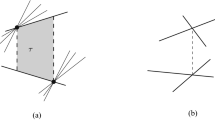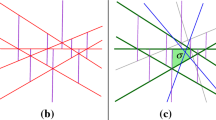Abstract
Given a set S of n points in the plane and an angle θ, a set of b+1 parallel lines l 0, l 1,...,l b of slope θ (b is fixed) is called a θ-cut of S if l 0, l 1,...,l b are equally spaced and all the points of S lie between l 0 and l b . The regions between two consecutive lines and called buckets. In this paper we consider the problem of finding an optimal θ-cut such that points are distributed into b buckets most uniformly, in other words, such that the maximum number of points to be included in one bucket is minimized. Comer and O'Donnell considered the problem under a constraint that l 0 and l b are two supporting lines of S and presented an algorithm which runs in O(bn 2 log bn) time and O(n 2+bn) space. In this paper we present two linear-space algorithm for the problem based on duality transformation. One runs in O(n 2+K log n+bn) time, where K is the number of intersections in the transformed plane. It is shown that K=O(n 2+bn). The other is advantageous if b<\(\sqrt n\)and runs in O(b 0.610 n 1.695+bn+K log n) time. Those are improvement of Comer and O'Donnell's algorithm both in time and space complexities. We also show that our algorithm can be extended to the case of buckets in the form of two-dimensional arrays.
Then, we extend our algorithm so as to solve the unconstrained version of the problem (l 0 and l b may not be supporting lines of S) in polynomial time. First we consider the one-dimensional case and then apply the idea to the two-dimensional case. Especially, the one-dimensional case is important from a standpoint of application to hashing. The problem we consider is as follows: Given a set of n real numbers x 0, x 1,...,x n−1 (we assume that they are sorted and x 0=0 and x n−1=1 without loss of generality). Consider a hash function of the form h(x)=[x−L/w] mod m, where we assume that [0−L/w]=0 and [1−L/w]=K−1 and K and m are given integers. It is easily seen that the hash function is more flexible than the ordinary form h(x)=[K·x] mod m since the latter hash function corresponds to the one in which L and w are fixed to be 0 and 1/K, respectively.
Preview
Unable to display preview. Download preview PDF.
Similar content being viewed by others
References
Te. Asano, L.J. Guibas and T. Tokuyama: Walking on an Arrangement Topologically, manuscript, 1990.
J.L. Bentley and T. Ottman: Algorithms for Reporting and Counting Geometric Intersections, IEEE Trans. Comput., vol. C-28, pp. 643–647, Sept. 1979.
B. Chazelle, L.J. Guibas, and D.T. Lee: The Power of Geometric Duality, Proc. 24th Symposium on Foundations of Computer Science, pp. 217–225, 1983.
B. Chazelle: Polytope Range Searching and Integral Geometry, Proc. 28th Symposium on Foundations of Computer Science, pp. 1–10, 1987.
D. Comer and M.J. O'Donnell: Geometric Problems with Applications to Hashing, SIAM J. Comput., vol. 11, No. 2, pp. 217–26, 1982.
H. Edelsbrunner: Algorithms in Combinatorial Geometry, EATCS Monographs in Theoretical Computer Science, vol. 10, Springer-Verlag Berlin Heidelberg, 1987.
H. Edelsbrunner and L. J. Guibas: Topologically Sweeping an Arrangement, Digital Systems Research Center, Research Report 9, 1986.
H. Edelsbrunner and E. Welzl: Half Planar Range Search in Linear Space and O(n 0.695) Query Time, Inform. Process. Lett. vol. 23, pp. 289–193, 1986.
F.P. Preparata and M.I. Shamos: Computational Geometry — An Introduction, Springer Verlag, New York, 1985.
E. Welzl: Partition Trees for Triangle Counting and Other Range Searching Problems, Proc. 4th Annual Symposium on Computational Geometry, pp. 23–33, Urbana-Champain, IL, June 1988.
D. Willard: Polygon Retrieval, SIAM J. Comput., vol. 11, pp. 149–165, 1982.
Author information
Authors and Affiliations
Editor information
Rights and permissions
Copyright information
© 1990 Springer-Verlag Berlin Heidelberg
About this paper
Cite this paper
Asano, T., Tokuyama, T. (1990). Algorithms for projecting points to give the most uniform distribution with applications to hashing. In: Asano, T., Ibaraki, T., Imai, H., Nishizeki, T. (eds) Algorithms. SIGAL 1990. Lecture Notes in Computer Science, vol 450. Springer, Berlin, Heidelberg. https://doi.org/10.1007/3-540-52921-7_79
Download citation
DOI: https://doi.org/10.1007/3-540-52921-7_79
Published:
Publisher Name: Springer, Berlin, Heidelberg
Print ISBN: 978-3-540-52921-7
Online ISBN: 978-3-540-47177-6
eBook Packages: Springer Book Archive




